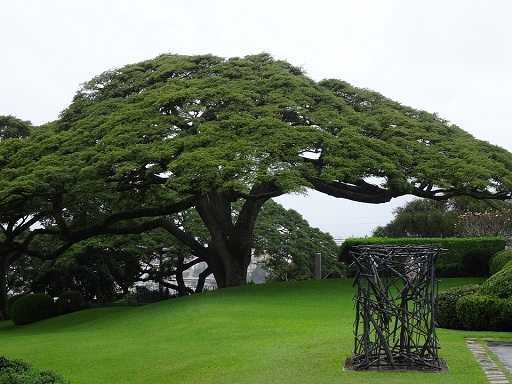

Looking at a rain tree (samanea-saman) takes me back to my school days.
Tall, and those trees having a wide spread are normally planted along roads to provide cover for pedestrians. Not only school kids even seniors are seen going for their morning walks in areas where jogging parks are absent. The only fear would be of droppings of birds perched up there. Most are not spared, not even me.
We used to walk to school which took us about 15 minutes to and fro. The road we used to walk had these rain trees planted along the left side of the road. Walking under the shade of these trees was a cool experience. We used to even carve our our names on the bark of these trees.
These trees were haven for birds where these birds built their nests and enjoyed the protection they provided. These trees bore beautiful pink flowers and fruits that looked like long black beans.
Once these beans were ripe they would fall to the ground and there used to be a carpet almost of these black beans.
These beans were edible and we kids used to enjoy them on our way to school and back. They were sweeter than any other fruit around. But for some reason our folks at home discouraged us from eating them. We would therefore have a good fill on the way and throw away anything left with us.
There used to be seeds that were to be discarded. Once mother caught me as some seeds had fallen in my school bag and that day I got a big hiding.
I still do not know why we were banned from eating these fruits.
Unfortunately when the project to widen the road was undertaken all these trees were chopped down.
I just thought how the kids could walk to school without any protection from the sun.
Nggak Nyangka! Hidup Gue Berubah Total! Gue bukan siapa-siapa. Cuma anak kos biasa yang kerja serabutan buat nutup biaya hidup… Read More
What is the Main Cause of a Heart Attack? What is its Solution? A heart attack is the blockage of… Read More
In the vast economic arena, one term that often takes center stage, inciting extensive debates and discussions, is the "debt… Read More
De-Dollarization: The Changing Face of Global Finance The financial landscape is in a state of flux, with an intriguing economic… Read More
The curtains closed on a dramatic Bundesliga season with Bayern Munich standing tall once again, clinching their 11th straight title.… Read More
The Unfolding Story of Celine Dion's Health In recent news that has left fans across the globe stunned, iconic singer… Read More
View Comments
Yes, it a shady tree and a heaven for the travelers tire of tiredness sitting under it feel peace of mind and heart. Rain tree is a common name for several plants and may refer to:
Albizia saman, a tree in the Fabaceae family, native to a range extending from Mexico south to Peru and Brazil. Brunfelsia a genus of shrubs and small trees in the Solanaceae family, native to the tropical Americas.
The most widely used common name for the species is raintree, from the belief that the tree produces rain at night. The leaflets close up at night or when under heavy cloud cover, allowing rain to pass easily through the crown. This trait may contribute to the frequently observed fact that grass remains green under the trees in times of drought.
However, the shading effect of the crown, the addition of nitrogen to the soil by decomposition of litter from this leguminous tree, and possibly, the sticky droppings of cicada insects in the trees all contribute to this phenomenon.
The Hawaiian common name, monkey-pod, is used here because it is a logical derivation of the scientific name Pithecellobium (monkey earring in Greek). Besides monkey-pod, raintree, and saman, which is its name throughout Latin America, the tree is called mimosa in the Philippines.